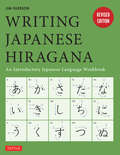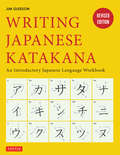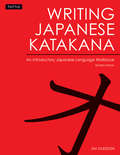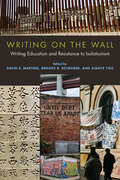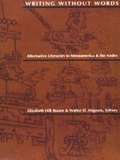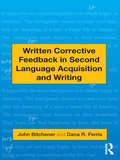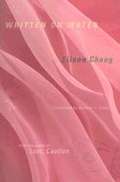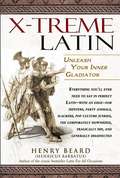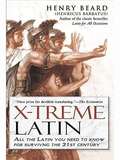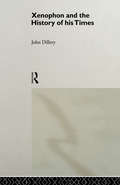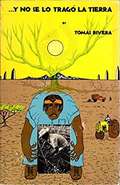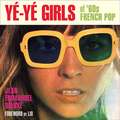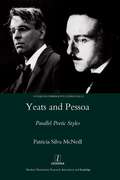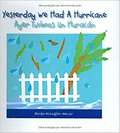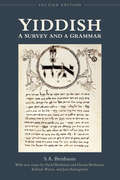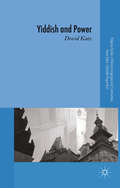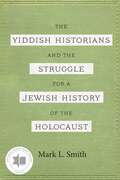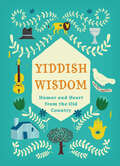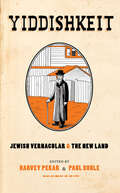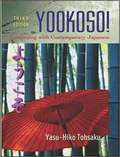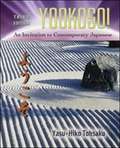- Table View
- List View
Writing Japanese Hiragana
by Jim GleesonThis guide presents exercises, review practices and lively illustrations, helping the reader to learn to write Hiragana.
Writing Japanese Hiragana
by Jim GleesonPut simply, practice is the most effective method of mastering written Japanese. The large, open format of Writing Japanese Hiragana invites the student to pick up a pencil and get started!Two phonetic syllabaries, hiragana and katakana, and a set of kanji characters based on Chinese ideographs are what comprises written Japanese. This workbook has been carefully designed to facilitate the quick and easy mastery of the forty-six character hiragana syllabary used to write all types of native words not written in kanji. An understanding of hiragana is essential for the serious student wishing to learn Japanese effectively.Each character is introduced with brushed, handwritten, and typed samples which enhance character recognition. Extensive writing space allows for maximum practice to facilitate memorization and ensure proper character formation. Entertaining illustrations and amusing examples of onomatopoeic usage of hiragana in Japanese writings further reinforce memorization in a fun way.Writing Japanese Hiragana is an easy-to-use and practical workbook tailored to the specific needs of young students of the Japanese language. Beginning students of all ages will delight in its fresh presentation.
Writing Japanese Hiragana
by Jim GleesonPut simply, practice is the most effective method of mastering written Japanese. The large, open format of Writing Japanese Hiragana invites the student to pick up a pencil and get started!Two phonetic syllabaries, hiragana and katakana, and a set of kanji characters based on Chinese ideographs are what comprises written Japanese. This workbook has been carefully designed to facilitate the quick and easy mastery of the forty-six character hiragana syllabary used to write all types of native words not written in kanji. An understanding of hiragana is essential for the serious student wishing to learn Japanese effectively.Each character is introduced with brushed, handwritten, and typed samples which enhance character recognition. Extensive writing space allows for maximum practice to facilitate memorization and ensure proper character formation. Entertaining illustrations and amusing examples of onomatopoeic usage of hiragana in Japanese writings further reinforce memorization in a fun way.Writing Japanese Hiragana is an easy-to-use and practical workbook tailored to the specific needs of young students of the Japanese language. Beginning students of all ages will delight in its fresh presentation.
Writing Japanese Katakana
by Jim GleesonThis is an introductory guide and workbook to writing Japanese Katakana.Anybody who is able to master English, with its irregular spellings and idiosyncratic pronunciations, is more than equipped to master written Japanese. The hiragana and katakana syllabaries are purely phonetic characters, which function much like the letters of the English alphabet. In this respect, kana are quite different from kanji characters, which are based on Chinese ideographs and which represent ideas. The katakana syllabary is used primarily to represent borrowed words (from languages other than Chinese), although it is also used for botanical names and is sometimes used in place of hiragana or kanji for emphasis. In some ways, the use of katakana in Japanese parallels the use of italics in English.Writing practice is the most effective method of mastering written Japanese, and the large open format of this workbook is designed to invite the student to pick up a pencil and start writing. Written Japanese comprises two phonetic syllabaries, hiragana and katakana, and a set of kanji characters that are based on Chinese ideographs. This workbook has been carefully designed to facilitate the quick and easy mastery of the 46-character katakana alphabet, making it the perfect tool to begin the process of mastering written Japanese. Each character is introduced with brushed, handwritten and typed samples that enhance character recognition. Extensive space for writing allows maximum practice to facilitate memorization and to ensure proper character formation. Entertaining illustrations and amusing examples of loan-words that use katakana in Japanese writings further reinforce memorization in a fun way. Writing Katakana is tailored to the specific needs of young students of the Japanese language, but is also well suited to beginning students of any age. This workbook contains: grayed-out, trace-over characters for correct character construction. Extensive practice in writing sentences for maximum reinforcement. Supplementary explanations, including a brief history of the origin of each character, to foster visual recall.
Writing Japanese Katakana
by Jim GleesonThis is an introductory guide and workbook to writing Japanese Katakana.Anybody who is able to master English, with its irregular spellings and idiosyncratic pronunciations, is more than equipped to master written Japanese. The hiragana and katakana syllabaries are purely phonetic characters, which function much like the letters of the English alphabet. In this respect, kana are quite different from kanji characters, which are based on Chinese ideographs and which represent ideas. The katakana syllabary is used primarily to represent borrowed words (from languages other than Chinese), although it is also used for botanical names and is sometimes used in place of hiragana or kanji for emphasis. In some ways, the use of katakana in Japanese parallels the use of italics in English.Writing practice is the most effective method of mastering written Japanese, and the large open format of this workbook is designed to invite the student to pick up a pencil and start writing. Written Japanese comprises two phonetic syllabaries, hiragana and katakana, and a set of kanji characters that are based on Chinese ideographs. This workbook has been carefully designed to facilitate the quick and easy mastery of the 46-character katakana alphabet, making it the perfect tool to begin the process of mastering written Japanese. Each character is introduced with brushed, handwritten and typed samples that enhance character recognition. Extensive space for writing allows maximum practice to facilitate memorization and to ensure proper character formation. Entertaining illustrations and amusing examples of loan-words that use katakana in Japanese writings further reinforce memorization in a fun way. Writing Katakana is tailored to the specific needs of young students of the Japanese language, but is also well suited to beginning students of any age. This workbook contains:grayed-out, trace-over characters for correct character constructionExtensive practice in writing sentences for maximum reinforcementSupplementary explanations, including a brief history of the origin of each character, to foster visual recall.
Writing Japanese Katakana
by Jim GleesonThis is an introductory guide and workbook to writing Japanese Katakana.Anybody who is able to master English, with its irregular spellings and idiosyncratic pronunciations, is more than equipped to master written Japanese. The hiragana and katakana syllabaries are purely phonetic characters, which function much like the letters of the English alphabet. In this respect, kana are quite different from kanji characters, which are based on Chinese ideographs and which represent ideas. The katakana syllabary is used primarily to represent borrowed words (from languages other than Chinese), although it is also used for botanical names and is sometimes used in place of hiragana or kanji for emphasis. In some ways, the use of katakana in Japanese parallels the use of italics in English.Writing practice is the most effective method of mastering written Japanese, and the large open format of this workbook is designed to invite the student to pick up a pencil and start writing. Written Japanese comprises two phonetic syllabaries, hiragana and katakana, and a set of kanji characters that are based on Chinese ideographs. This workbook has been carefully designed to facilitate the quick and easy mastery of the 46-character katakana alphabet, making it the perfect tool to begin the process of mastering written Japanese. Each character is introduced with brushed, handwritten and typed samples that enhance character recognition. Extensive space for writing allows maximum practice to facilitate memorization and to ensure proper character formation. Entertaining illustrations and amusing examples of loan-words that use katakana in Japanese writings further reinforce memorization in a fun way. Writing Katakana is tailored to the specific needs of young students of the Japanese language, but is also well suited to beginning students of any age. This workbook contains:grayed-out, trace-over characters for correct character constructionExtensive practice in writing sentences for maximum reinforcementSupplementary explanations, including a brief history of the origin of each character, to foster visual recall.
Writing on the Wall: Writing Education and Resistance to Isolationism
by Xiaoye You David S. Martins Brooke R. SchreiberThe first concerted effort of writing studies scholars to interrogate isolationism in the United States, Writing on the Wall reveals how writing teachers—often working directly with students who are immigrants, undocumented, first-generation, international, and students of color—embody ideas that counter isolationism. The collection extends existing scholarship and research about the ways racist and colonial rhetorics impact writing education; the impact of translingual, transnational, and cosmopolitan ideologies on student learning and student writing; and the role international educational partnerships play in pushing back against isolationist ideologies. Established and early-career scholars who work in a broad range of institutional contexts highlight the historical connections among monolingualism, racism, and white nationalism and introduce community- and classroom-based practices that writing teachers use to resist isolationist beliefs and tendencies. “Writing on the wall” serves as a metaphor for the creative, direct action writing education can provide and invokes border spaces as sites of identity expression, belonging, and resistance. The book connects transnational writing education with the fight for racial justice in the US and around the world and will be of significance to secondary and postsecondary writing teachers and graduate students in English, linguistics, composition, and literacy studies. Contributors: Olga Aksakalova, Sara P. Alvarez, Brody Bluemel, Tuli Chatterji, Keith Gilyard, Joleen Hanson, Florianne Jimenez Perzan, Rebecca Lorimer Leonard, Layli Maria Miron, Tony D. Scott, Kate Vieira, Amy J. Wan
Writing Without Words: Alternative Literacies in Mesoamerica and the Andes
by Elizabeth Hill Boone Walter D. MignoloThe history of writing, or so the standard story goes, is an ascending process, evolving toward the alphabet and finally culminating in the "full writing" of recorded speech. Writing without Words challenges this orthodoxy, and with it widespread notions of literacy and dominant views of art and literature, history and geography. Asking how knowledge was encoded and preserved in Pre-Columbian and early colonial Mesoamerican cultures, the authors focus on systems of writing that did not strive to represent speech. Their work reveals the complicity of ideology in the history of literacy, and offers new insight into the history of writing.The contributors--who include art historians, anthropologists, and literary theorists--examine the ways in which ancient Mesoamerican and Andean peoples conveyed meaning through hieroglyphic, pictorial, and coded systems, systems inseparable from the ideologies they were developed to serve. We see, then, how these systems changed with the European invasion, and how uniquely colonial writing systems came to embody the post-conquest American ideologies. The authors also explore the role of these early systems in religious discourse and their relation to later colonial writing.Bringing the insights from Mesoamerica and the Andes to bear on a fundamental exchange among art history, literary theory, semiotics, and anthropology, the volume reveals the power contained in the medium of writing.Contributors. Elizabeth Hill Boone, Tom Cummins, Stephen Houston, Mark B. King, Dana Leibsohn, Walter D. Mignolo, John Monaghan, John M. D. Pohl, Joanne Rappaport, Peter van der Loo
Written Corrective Feedback in Second Language Acquisition and Writing
by John Bitchener Dana R. FerrisWhat should language and writing teachers do about giving students written corrective feedback? This book surveys theory, research, and practice on the important and sometimes controversial issue of written corrective feedback, also known as “error/grammar correction,” and its impact on second language acquisition and second language writing development. Offering state-of-the-art treatment of a topic that is highly relevant to both researchers and practitioners, it critically analyzes and synthesizes several parallel and complementary strands of research — work on error/feedback (both oral and written) in SLA and studies of the impact of error correction in writing/composition courses — and addresses practical applications. Drawing from both second language acquisition and writing/composition literature, this volume is the first to intentionally connect these two separate but important lines of inquiry.
Written on Water
by Eileen Chang Andrew Jones Ailing Zhang Nicole HuangKnown as "the Garbo of Chinese letters" for her elegance and the aura of mystery that surrounded her, Eileen Chang is regarded as one of the greatest and most influential modern Chinese novelists and cultural critics of the twentieth century. In Written on Water, first published in 1945 and now available for the first time in English, Chang offers essays on art, literature, war, and urban life, as well as autobiographical reflections. Chang takes in the sights and sounds of wartime Shanghai and Hong Kong, with the tremors of national upheaval and the drone of warplanes in the background, and inventively fuses explorations of urban life, literary trends, domestic habits, and historic events. These evocative and moving firsthand accounts examine the subtle and not-so-subtle effects of the Japanese bombing and occupation of Shanghai and Hong Kong. Eileen Chang writes of friends, colleagues, and teachers turned soldiers or wartime volunteers, and her own experiences as a part-time nurse. Her nuanced depictions range from observations of how a woman's elegant dress affects morale to descriptions of hospital life. With a distinctive style that is at once meditative, vibrant, and humorous, Chang engages the reader through sly, ironic humor; an occasionally chatty tone; and an intense fascination with the subtleties of modern urban life. The collection vividly captures the sights and sounds of Shanghai, a city defined by its mix of tradition and modernity. Chang explores the city's food, fashions, shops, cultural life, and social mores; she reveals and upends prevalent attitudes toward women and in the process presents a portrait of a liberated, cosmopolitan woman, enjoying the opportunities, freedoms, and pleasures offered by urban life. In addition to her descriptions of daily life, Chang also reflects on a variety of artistic and literary issues, including contemporary films, the aims of the writer, the popularity of the Peking Opera, dance, and painting.
X-Treme Latin: Lingua Latina Extrema
by Henry BeardEverything you'll need to say in Latin for hipsters, party animals, slackers, pop-culture junkies, the corporately downsized and generally disaffected
X-Treme Latin
by Henry BeardIn staff meetings and singles bars, on freeways and fairways, there are aggravating people lurking everywhere these days. But bestselling humorist Henry Beard has the perfect comeback for all prickly situations, offering a slew of quips your nemesis won't soon forget . . . or even understand. Beard's gift is his ability to make fun of popular culture and the current zeitgeist. In X-Treme Latin he provides Latin with an attitude, an indispensable phrasebook that taps the secret power of Latin to deliver, in total safety, hundreds of impeccable put-downs, comebacks, and wisecracks. Within its pages you will learn how to insult or fire coworkers; blame corporate scandals on someone else; cheer at a World Wrestling Entertainment match; talk back to your computer, TV, or Game Boy; deal with your road rage; evade threatening situations; snowboard in style; talk like Tony Soprano; and much more. With dozens more zingers for quashing e-mail pranks, psyching out your golf opponent, giving backhanded compliments, and evading awkward questions, X-Treme Latin is destined for magnus popularity and will have readers cheering, "Celebremus!"
Xenophon And The History Of His Times
by John DilleryXenophon and the History of his Times examines Xenophon's longer historical works, the Hellenica and the Anabasis. Dillery considers how far these texts reflect the Greek intellectual world of the fourth and fifth centuries B.C., rather than focusing on the traditional question of how accurate they are as histories. Through analysis of the complete corpus of Xenophon's work, and the writings of his contemporaries, Xenophon is shown to be very much a man of his times, concerned with topical issues ranging from panhellenism and utopia to how far the gods controlled human history.This book will be valuable reading for students on ancient history courses and for all those interested in Greek political and philosophical thought.
Yapese Alphabet (Island Alphabet Books)
by Lori PhillipsThis book is part of the Island Alphabet Books series, which features languages and children's artwork from the U.S.-affiliated Pacific. Each book contains the complete alphabet for the language, four or five examples for each letter, and a word list with English translations. The series is published by PREL, a non- profit corporation that works collaboratively with school systems to enhance education across the Pacific.
Yé-Yé Girls of '60s French Pop
by Lio Jean-Emmanuel DeluxeThis delightfully illustrated exploration into '60s French pop, and the women who built it, reveals yé-yé music's hip sensuality, humor, style and wit. We hear from and about Françoise Hardy, France Gall, Brigitte Bardot, Sylvie Vartan and dozens of other modern Lolitas, and the recklessly naughty Serge Gainsbourg. Modern-day yé-yé avatar Lio has written the book's Foreword.
Yeats and Pessoa: Parallel Poetic Styles
by Patricia Silva-McNeillW. B. Yeats and Fernando Pessoa (1888-1935) regarded style as a tool for metaphysical inquiry and, consequently, they adopted distinct poetic styles to convey different attitudes towards experience. Silva-McNeill's study examines how the poets' stylistic diversification was a means of rehearsing different existential and aesthetic stances. It identifies parallels between their styles from a comparative case studies approach. Their stylistic masks allowed them to maintain the subjectivity and authenticity associated with the lyrical genre, while simultaneously attaining greater objectivity and conveying multiple perspectives. The poets continuously transformed the fond and form of their verse, creating a protean lyrical voice that expressed their multilateral poetic temperament and reflected the depersonalisation and formal experimentalism of the modern lyric.
Yesterday We Had a Hurricane / Ayer Tuvimos Un Huracán
by Deirdre McLaughlin MercierThis bilingual edition re-tells the experience of a hurricane as seen through the eyes of a young child. Young readers will learn all about these big storms that come from the ocean. They'll find out about the effects of wind and rain, as well as some of the more lighthearted and practical alternatives to doing without electricity.
Yiddish: A Survey and a Grammar, Second Edition
by Kalman Weiser Eleazar Birnbaum S. A. Birnbaum David Birnbaum Jean BaumgartenOne of the great Yiddish scholars of the twentieth century, S.A. Birnbaum (1891-1989) published Yiddish: A Survey and a Grammar in 1979 towards the end of a long and prolific career. Unlike other grammars and study guides for English speakers, Yiddish: A Survey and a Grammar fully describes the Southern Yiddish dialect and pronunciation used today by most native speakers, while also taking into account Northern Yiddish and Standard Yiddish, associated with secularist and academic circles. The book also includes specimens of Yiddish prose and poetic texts spanning eight centuries, sampling Yiddish literature from the medieval to modern eras across its vast European geographic expanse.The second edition of Yiddish: A Survey and a Grammar makes this classic text available again to students, teachers, and Yiddish-speakers alike. Featuring three new introductory essays by noted Yiddish scholars, a corrected version of the text, and an expanded and updated bibliography, this book is essential reading for any serious student of Yiddish and its culture.
Yiddish and Power
by Dovid KatzYiddish and Power surveys the social, linguistic and intellectual history of the Yiddish language within the traditional civilisation of Jewish Ashkenaz in central, and then in eastern Europe, and its interaction with the surrounding non-Jewish culture. It explores the various ways in which Yiddish has empowered masses and served political agendas.
The Yiddish Historians and the Struggle for a Jewish History of the Holocaust
by Mark L. SmithThe Yiddish Historians and the Struggle for a Jewish History of the Holocaust identifies the Yiddish historians who created a distinctively Jewish approach to writing Holocaust history in the early years following World War II. Author Mark L. Smith explains that these scholars survived the Nazi invasion of Eastern Europe, yet they have not previously been recognized as a specific group who were united by a common research agenda and a commitment to sharing their work with the worldwide community of Yiddish-speaking survivors. These Yiddish historians studied the history of the Holocaust from the perspective of its Jewish victims, focusing on the internal aspects of daily life in the ghettos and camps under Nazi occupation and stressing the importance of relying on Jewish sources and the urgency of collecting survivor testimonies, eyewitness accounts, and memoirs. With an aim to dispel the accusations of cowardice and passivity that arose against the Jewish victims of Nazism, these historians created both a vigorous defense and also a daring offense. They understood that most of those who survived did so because they had engaged in a daily struggle against conditions imposed by the Nazis to hasten their deaths. The redemption of Jewish honor through this recognition is the most innovative contribution by the Yiddish historians. It is the area in which they most influenced the research agendas of nearly all subsequent scholars while also disturbing certain accepted truths, including the beliefs that the earliest Holocaust research focused on the Nazi perpetrators, that research on the victims commenced only in the early 1960s and that Holocaust study developed as an academic discipline separate from Jewish history. Now, with writings in Yiddish journals and books in Europe, Israel, and North and South America having been recovered, listed, and given careful discussion, former ideas must yield before the Yiddish historians’ published works. The Yiddish Historians and the Struggle for a Jewish History of the Holocaust is an eye-opening monograph that will appeal to Holocaust and Jewish studies scholars, students, and general readers.
Yiddish Wisdom: Humor and Heart from the Old Country
by Christopher Silas NealDecade after decade, Yiddish proverbs continue to capture the humor, warmth, and traditions of Jewish life. Now, the beloved Yiddish Wisdom has been expanded with even more proverbs and fresh illustrations to be cherished by a new generation. With more than 150 folk sayings translated in Yiddish and English--from the whimsical and witty (Dress up a broom and it will also look nice/Az men batziert a bezem iz er oich shain) to the poignant (When one must, one can/Az me muz, ken men) and practical (When you look to the heights, hold on to your hat/Az du kukst oif hoicheh zachen, halt tsu dos hitl)--this treasured volume is the perfect gift for any celebration.
Yiddishkeit: Jewish Vernacular & the New Land
by Harvey Pekar and Paul BuhleA “fascinating and enlightening” collection of comics and writings that explore the Yiddish language and the Jewish experience (The Miami Herald).We hear words like nosh, schlep, and schmutz, but how did they come to pepper American English? In Yiddishkeit, Harvey Pekar and Paul Buhle trace the far-reaching influences of Yiddish from medieval Europe to the tenements of New York’s Lower East Side. This comics anthology contains original stories by such notable writers and artists as Barry Deutsch, Peter Kuper, Spain Rodriguez, and Sharon Rudahl. Through illustrations, comics art, and a full-length play, four major themes are explored: culture, performance, assimilation, and the revival of the language. “The book is about what Neal Gabler in his introduction labels ‘Jewish sensibility.’…he writes: ‘You really can’t define Yiddishkeit neatly in words or pictures. You sort of have to feel it by wading into it.’ The book does this with gusto.” —TheNew York Times“As colorful, bawdy, and charming as the culture it seeks to represent.” —Print magazine“Brimming with the charm and flavor of its subject…a genuinely compelling, scholarly comics experience.” —Publishers Weekly“A book that truly informs about Jewish culture and, in the process, challenges readers to pick apart their own vocabulary.” —Chicago Tribune“A postvernacular tour de force.” —The Forward“With a loving eye Pekar and Buhle extract moments and personalities from Yiddish history.” —Hadassah“Gorgeous comix-style portraits of Yiddish writers.”––Tablet “Yiddishkeit has managed to survive, if just barely…because [it] is an essential part of both the Jewish and the human experience.” —Neal Gabler, author of An Empire of Their Own: How the Jews Invented Hollywood, from his introduction“A scrumptious smorgasbord of comics, essays, and illustrations…concentrated tastes, with historical context, of Yiddish theater, literature, characters and culture.” —Heeb magazine
